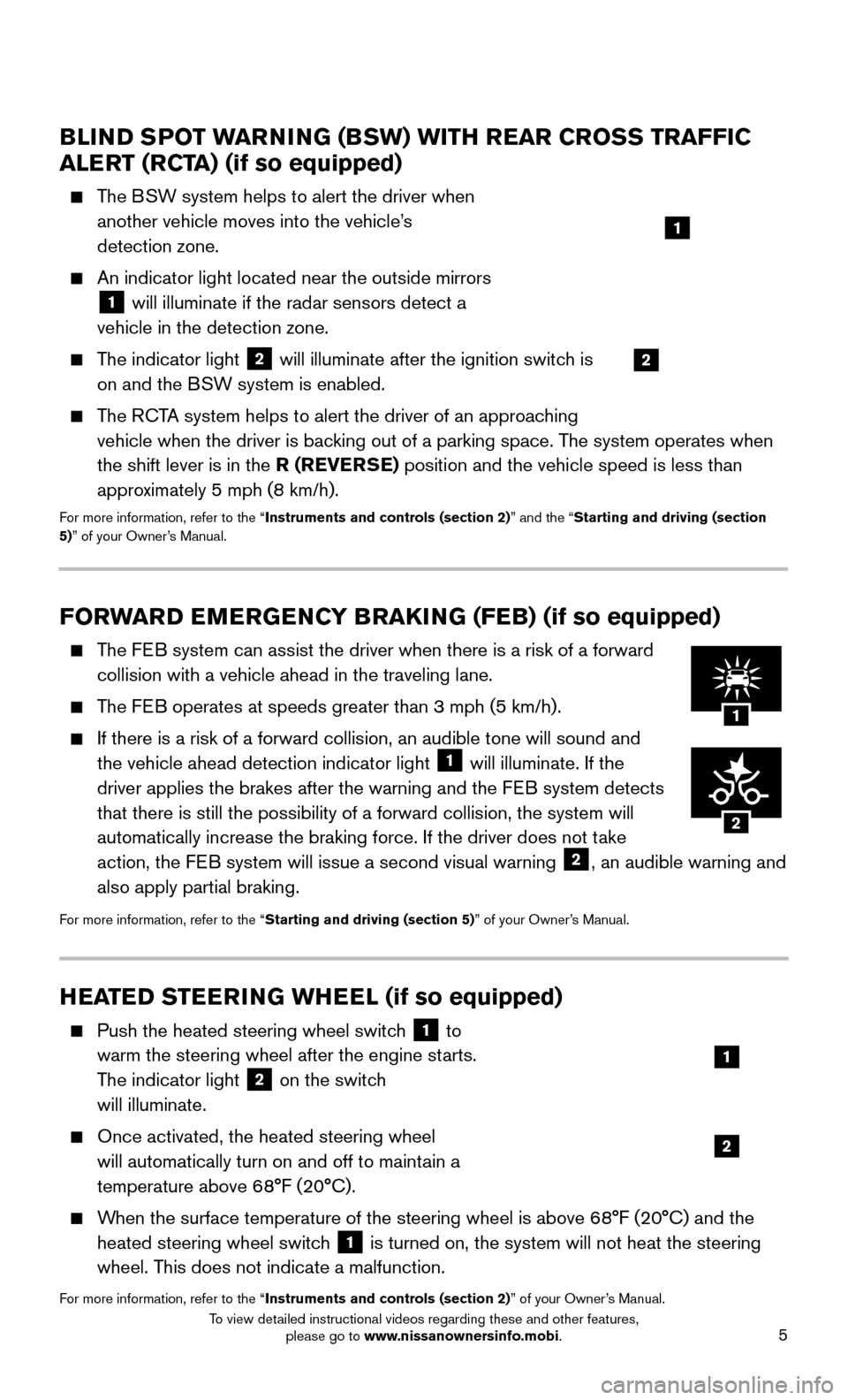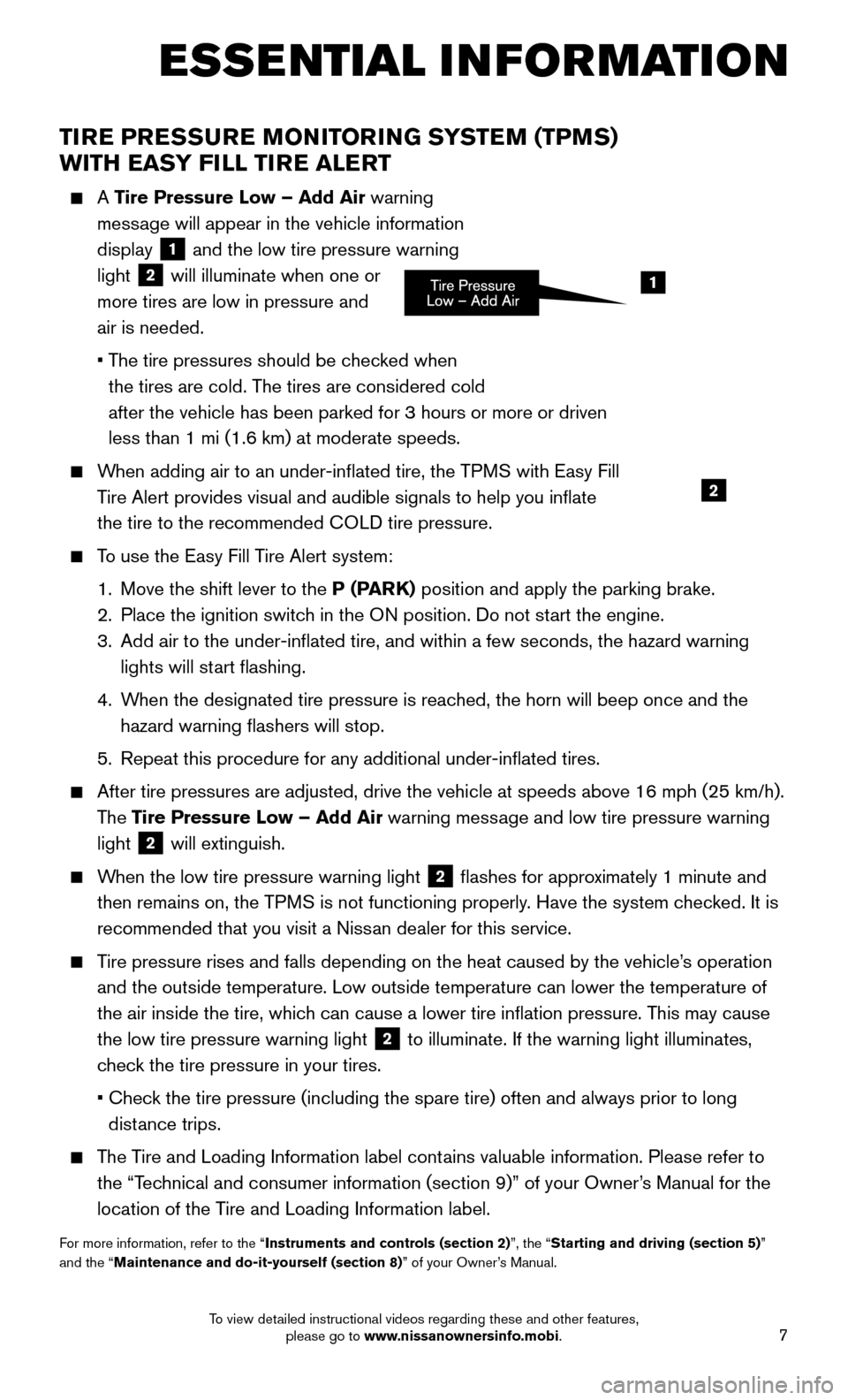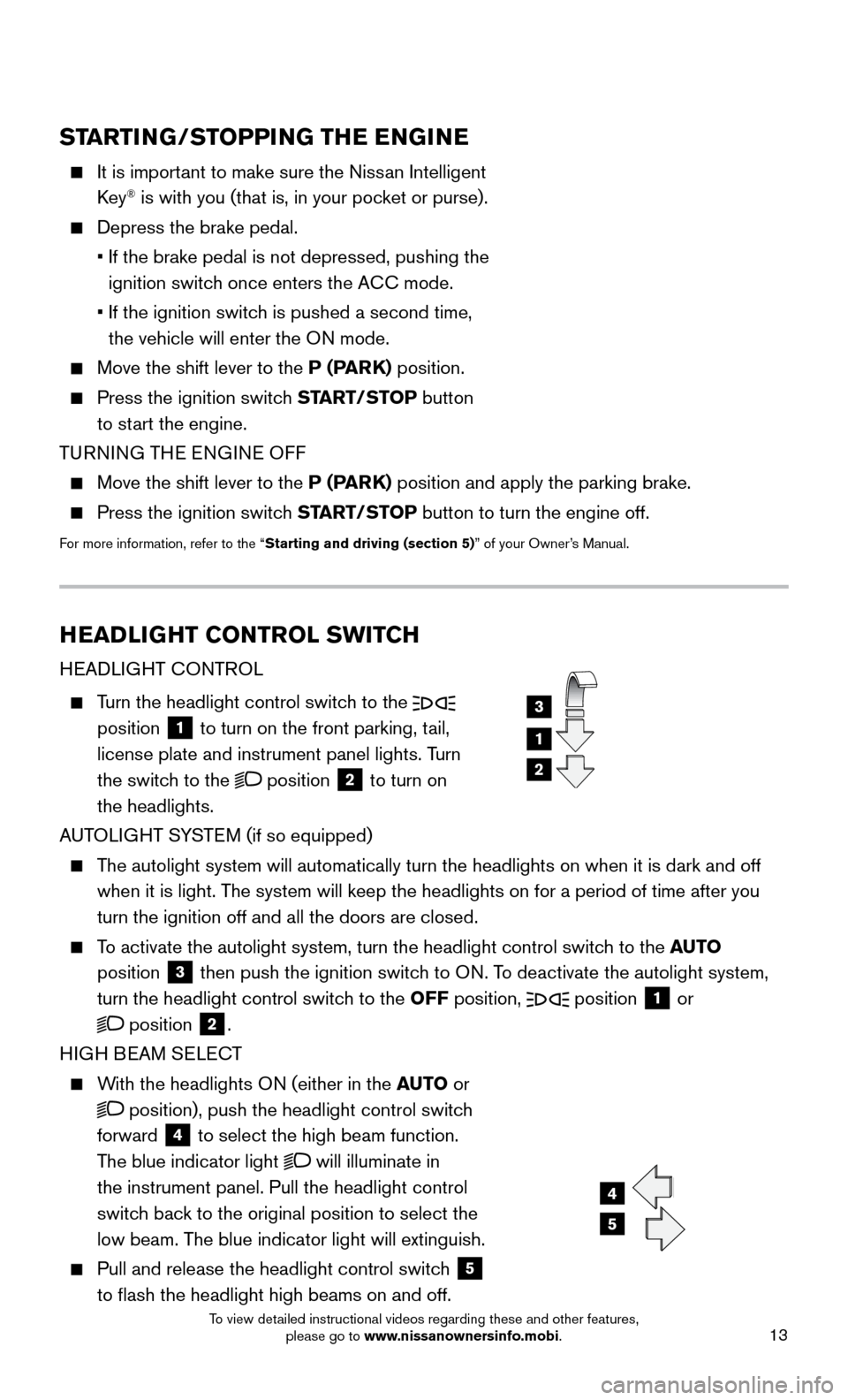2016 NISSAN ALTIMA parking brake
[x] Cancel search: parking brakePage 7 of 32

5
BLIND SPOT WARNING (BSW) WITH REAR CROSS TRAFFIC
ALERT (RCTA) (if so equipped)
The BSW system helps to alert the driver when
another vehicle moves into the vehicle’s
detection zone.
An indicator light located near the outside mirrors
1 will illuminate if the radar sensors detect a
vehicle in the detection zone.
The indicator light 2 will illuminate after the ignition switch is
on and the BSW system is enabled.
The RCTA system helps to alert the driver of an approaching
vehicle when the driver is bac king out of a parking space. The system operates when
the shift lever is in the R (REVERSE) position and the vehicle speed is less than
approximately 5 mph (8 km/h).
For more information, refer to the “Instruments and controls (section 2)” and the “Starting and driving (section
5)” of your Owner’s Manual.
1
FORWARD EMERGENCY BRAKING (FEB) (if so equipped)
The FEB system can assist the driver when there is a risk of a forward
collision with a vehicle ahead in the traveling lane.
The FEB operates at speeds greater than 3 mph (5 km/h).
If there is a risk of a forward collision, an audible tone will sound an\
d
the vehicle ahead detection indicator light 1 will illuminate. If the
driver applies the brakes after the warning and the FEB system detects
that there is still the possibility of a forward collision, the system w\
ill
automatically increase the braking force. If the driver does not take
action, the FEB system will issue a second visual warning
2, an audible warning and
also apply partial braking.
For more information, refer to the “Starting and driving (section 5)” of your Owner’s Manual.
2
1
2
2 11
2
HEATED STEERING WHEEL (if so equipped)
Push the heated steering wheel switch 1 to
warm the steering wheel after the engine starts.
The indicator light
2 on the switch
will illuminate.
Once activated, the heated steering wheel
will automatically turn on and off to maintain a
temperature above 6
8°F (20°C).
When the surface temperature of the steering wheel is above 68°F (20°C) and the
heated steering wheel switc h
1 is turned on, the system will not heat the steering
wheel. This does not indicate a malfunction.
For more information, refer to the “Instruments and controls (section 2)” of your Owner’s Manual.
1
2
To view detailed instructional videos regarding these and other features, please go to www.nissanownersinfo.mobi.
Page 9 of 32

7
ESSE NTIAL I N FOR MATION
TIRE PRESSURE MONITORING SYSTEM (TPMS)
WITH EASY FILL TIRE ALERT
A Tire Pressure Low – Add Air warning
mess age will appear in the vehicle information
display
1 and the low tire pressure warning
light
2 will illuminate when one or
more tires are low in pressure and
air is needed.
• The tire pressures should be c
hecked when
the tires are cold. The tires are considered cold
after the vehicle has been parked for 3 hours or more or driven
less than 1 mi (1.6 km) at moderate speeds.
When adding air to an under-inflated tire, the TPMS with Easy Fill
T ire Alert provides visual and audible signals to help you inflate
the tire to the recommended COLD tire pressure.
To use the Easy Fill Tire Alert system:
1. Move the shift lever to the P (P
ARK) position and apply the parking brake.
2. Place the ignition switch in the O
N position. Do not start the engine.
3.
Add air to the under-inflated tire, and within a few seconds, the haza\
rd warning
lights will start flashing.
4.
When the designated tire pressure is reac
hed, the horn will beep once and the
hazard warning flashers will stop.
5.
Repeat this procedure for any additional under-inflated tires.
After tire pressures are adjusted, drive the vehicle at speeds above 16 \
mph (25 km/h).
The Tire Pressure Low – Add Air warning message and low tire pressure warning
light
2 will extinguish.
When the low tire pressure warning light 2 flashes for approximately 1 minute and
then remains on, the TPMS is not functioning properly. Have the system checked. It is
recommended that you visit a Nissan dealer for this service.
Tire pressure rises and falls depending on the heat caused by the vehicle\
’s operation
and the outside temperature. Low outside temperature can lower the tempe\
rature of
the air inside the tire, whic
h can cause a lower tire inflation pressure. This may cause
the low tire pressure warning light
2 to illuminate. If the warning light illuminates,
check the tire pressure in your tires.
• Check the tire pressure (including the spare tire) often and always prior \
to long
dist
ance trips.
The Tire and Loading Information label contains valuable information. Please refer to
the “T echnical and consumer information (section 9)” of your Owner’s Manual for the
location of the Tire and Loading Information label.
For more information, refer to the “Instruments and controls (section 2)”, the “Starting and driving (section 5)”
and the “Maintenance and do-it-yourself (section 8)” of your Owner’s Manual.
1
2
To view detailed instructional videos regarding these and other features, please go to www.nissanownersinfo.mobi.
Page 12 of 32

10
NISSAN INTELLIGENT KEY® SYSTE M
The Nissan Intelligent Key® system allows you to lock or unlock
your vehicle, open your trunk and remotely start the engine. It is
important to make sure the Intelligent Key is with you (that is, in your
pocket or purse).
REMOTE ENGINE START* (if so equipped)
The remote start operating range is approximately 200 ft (60 m)
from the vehicle. T he remote engine start feature will not operate
if the Intelligent Key is inside the vehicle. The effective operating
range may be shorter if there are walls or other obstructions
between the key and the vehicle.
For remote start to function, the vehicle must be in the P (PARK)
position with the ignition off and all of the doors must be closed
and loc
ked. Please see your Owner’s Manual for additional information.
To start your vehicle remotely:
1. Press the button 1.
2.
Within 5 seconds, press and hold the engine st
art
button 2 for at least
2 seconds.
The engine will start, and the parking lights will turn on.
Automatic climate control will begin heating or cooling the vehicle depe\
nding on the
outside temperature.
The engine will run for 10 minutes and then turn off.
• You must wait at least 6 seconds before remotely st
arting the engine again.
Repeat steps 1 and 2 to extend the time for an additional 10-minute period.
• After two remote starts, the ignition switc
h must be cycled before remote start can
be used again.
To start driving, depress the brake pedal and press the ignition switch
ST ART/STOP button.
LOCKING AND UNLOCKING THE VEHICLE
The lock and unlock operating range of the
Intelligent K ey is within 31.5 in (80 cm) from
each request switch.
To lock the vehicle, push either door handle
request switc h
3 once or press the button
1 on the key fob.
1
2
4
5
6
*State laws may apply; review local laws before using.
3
FIRST DRIVE FEATURES
To view detailed instructional videos regarding these and other features, please go to www.nissanownersinfo.mobi.
Page 15 of 32

13
HEADLIGHT CONTROL SWITCH
HEADLIGHT CONTROL
Turn the headlight control switch to the
position 1 to turn on the front parking, tail,
license plate and instrument panel lights. Turn
the switch to the
position 2 to turn on
the headlights.
AUTOLIGHT SYSTEM (if so equipped)
The autolight system will automatically turn the headlights on when it is\
dark and off
when it is light. T he system will keep the headlights on for a period of time after you
turn the ignition off and all the doors are closed.
To activate the autolight system, turn the headlight control switch to the AUTO
position
3 then push the ignition switch to ON. To deactivate the autolight system,
turn the headlight control switch to the OFF position,
position 1 or
position 2.
HIGH BEAM SELECT
With the headlights ON (either in the AUTO or
position), push the headlight control switch
forward
4 to select the high beam function.
The blue indicator light
will illuminate in
the instrument panel. Pull the headlight control
switch back to the original position to select the
low beam. The blue indicator light will extinguish.
Pull and release the headlight control switch 5
to flash the headlight high beams on and off.
1
3
2
4
5
STARTING/STOPPING THE ENGINE
It is important to make sure the Niss an Intelligent
Key® is with you (that is, in your pocket or purse).
Depress the brake pedal.
• If the brake pedal is not depressed, pushing the
ignition switch once enters the A
CC mode.
• If the ignition switch is pushed a second time,
the vehicle will enter the O
N mode.
Move the shift lever to the P (P ARK) position.
Press the ignition switch START/STOP button
to start the engine.
TURNING THE ENGINE OFF
Move the shift lever to the P (P ARK) position and apply the parking brake.
Press the ignition switch START/STOP button to turn the engine off.
For more information, refer to the “Starting and driving (section 5)” of your Owner’s Manual.
To view detailed instructional videos regarding these and other features, please go to www.nissanownersinfo.mobi.